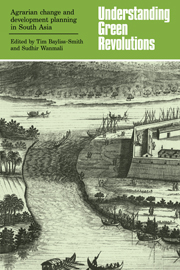Book contents
- Frontmatter
- Contents
- List of contributors
- Preface
- I Understanding Green Revolutions: an overview
- II Agrarian change at village level
- III Development planning and agrarian change
- 12 Rural-based models for rural development: the Indian experience
- 13 Planning and agrarian change in East Africa: appropriate and inappropriate models for land settlement schemes
- 14 Metropolitan expansion in India: spatial dynamics and rural transformation
- 15 Green Revolution and water demand: irrigation and ground water in Sri Lanka and Tamil Nadu
- 16 Social organisation and irrigation: ideology, planning and practice in Sri Lanka's settlement schemes
- 17 Environmental hazard and coastal reclamation: problems and prospects in Bangladesh
- 18 Beyond the Green Revolution: a selective essay
- Index
15 - Green Revolution and water demand: irrigation and ground water in Sri Lanka and Tamil Nadu
Published online by Cambridge University Press: 25 May 2010
- Frontmatter
- Contents
- List of contributors
- Preface
- I Understanding Green Revolutions: an overview
- II Agrarian change at village level
- III Development planning and agrarian change
- 12 Rural-based models for rural development: the Indian experience
- 13 Planning and agrarian change in East Africa: appropriate and inappropriate models for land settlement schemes
- 14 Metropolitan expansion in India: spatial dynamics and rural transformation
- 15 Green Revolution and water demand: irrigation and ground water in Sri Lanka and Tamil Nadu
- 16 Social organisation and irrigation: ideology, planning and practice in Sri Lanka's settlement schemes
- 17 Environmental hazard and coastal reclamation: problems and prospects in Bangladesh
- 18 Beyond the Green Revolution: a selective essay
- Index
Summary
The subject of irrigation and ground-water supply in South Asia has remained close to the heart of B.H. Farmer since the 1950s. In particular, his early contributions on rainfall and water supply in the Dry Zone of Sri Lanka (Farmer, 1951, 1954, 1956a) and on ‘Land use lessons learnt in Madras applicable to the Dry Zone of Ceylon’ (Farmer, 1956b) stand unparalleled in this field even today, not only for their academic content, but also because of the vistas they opened for further research and for actual water resources development in the areas concerned. The intention of the writer in presenting this chapter, as one who has had the privilege of direct access to the wealth, of Farmer's academic experience, is to review and update the knowledge on this important subject in relation to those lands where Farmer made his pioneering studies, namely, the Dry Zone of Sri Lanka, and the Tamil Nadu of South India. The essay also focusses attention on rice fields and Green Revolutions which have represented Farmer's most recent research interests.
History of Sri Lankan irrigation
For centuries irrigation had been an art, a science, and a way of life to the people living in the drier areas of South Asia. Many cities and settlements emerged and flourished in irrigated hinterlands. In some cases the dependence of communities on irrigation was so heavy as to warrant the use of the term ‘hydraulic societies’ by certain scholars to describe such civilizations (Leach, 1959; Gunawardhana, 1979). On the other hand highly developed civilizations have collapsed and disintegrated due to the decay of these stupendous irrigation systems (Murphy, 1957).
- Type
- Chapter
- Information
- Understanding Green RevolutionsAgrarian Change and Development Planning in South Asia, pp. 296 - 314Publisher: Cambridge University PressPrint publication year: 1984
- 1
- Cited by



